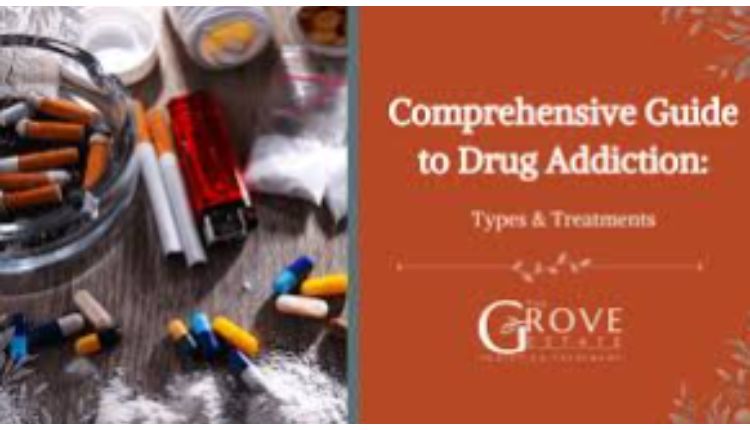
Drug
Drug addiction is a serious and often life-threatening condition that affects millions of people worldwide. It can disrupt every aspect of a person’s life, including their health, relationships, and overall well-being. For many, rehab serves as a vital step toward recovery. Rehab for drug addiction offers individuals a structured environment where they can receive the support, treatment, and resources needed to overcome substance abuse. This article will explore what rehab for drug addiction, the types of programs available, the therapies used, and how to choose the right facility for effective recovery.
What is Drug Rehab?
Rehab, or rehabilitation, is a structured treatment process designed to help individuals overcome drug addiction. It typically involves a combination of medical care, psychological therapy, and supportive services aimed at addressing the physical, emotional, and social aspects of addiction. The primary goal of rehab is to help individuals stop using drugs, maintain sobriety, and rebuild their lives.
Rehab programs can be categorized into several types, such as inpatient, outpatient, and residential rehab, each offering different levels of care. The choice of program depends on the severity of the addiction, the substance involved, and the individual’s personal circumstances.
Types of Drug Rehab Programs
- Inpatient Rehab
Inpatient rehab, also known as residential treatment, involves staying at a treatment facility for an extended period, usually ranging from 28 days to several months. This type of rehab is ideal for individuals with severe addictions, co-occurring mental health disorders, or those who have relapsed multiple times. Inpatient rehab provides a structured, supportive environment where individuals can focus entirely on their recovery without distractions or access to drugs.
Key benefits of inpatient rehab include:
-
- 24/7 medical supervision and support
- A structured daily schedule that includes therapy, activities, and wellness programs
- A safe, drug-free environment
- Outpatient Rehab
Outpatient rehab allows individuals to live at home while attending treatment sessions at a rehab center during the day. This type of program is suitable for those with mild to moderate addiction who have a strong support system at home. Outpatient programs offer flexibility, enabling participants to maintain their daily responsibilities, such as work, school, or family commitments, while receiving treatment.
Outpatient rehab can be further divided into:
-
- Standard Outpatient Programs (OP): Typically involve a few hours of therapy per week.
- Intensive Outpatient Programs (IOP): Require more frequent visits, often several times a week, for longer therapy sessions.
- Partial Hospitalization Programs (PHP): Offer a higher level of care than IOPs, with participants attending treatment for several hours each day, five to seven days a week.
- Detox Programs
Detoxification, or detox, is often the first step in the rehab process, especially for individuals who have developed physical dependence on a substance. Detox involves the removal of drugs from the body and is usually supervised by medical professionals who can manage withdrawal symptoms and ensure the patient’s safety.
The detox process can vary depending on the substance used, the duration of addiction, and the individual’s overall health. In some cases, medication may be prescribed to alleviate withdrawal symptoms and reduce cravings.
- Sober Living Homes
Sober living homes, or halfway houses, provide a transitional living environment for individuals who have completed an inpatient rehab program but are not yet ready to return to their daily lives. These homes offer a structured, drug-free setting where residents can continue their recovery while gradually reintegrating into society.
Key benefits include:
-
- Peer support from others in recovery
- A structured environment with rules and responsibilities
- Continued access to outpatient therapy or support groups
Therapies and Treatments Used in Drug Rehab
Effective drug rehab programs use a variety of therapeutic approaches tailored to the individual’s specific needs. Common types of therapies and treatments include:
- Behavioral Therapies
Behavioral therapies are a cornerstone of addiction treatment, focusing on changing the patterns of behavior and thinking that contribute to drug use. Common behavioral therapies include:
-
- Cognitive-Behavioral Therapy (CBT): Helps individuals identify and change negative thought patterns and behaviors associated with drug use.
- Dialectical Behavior Therapy (DBT): A form of CBT that focuses on managing emotions and developing coping strategies, especially useful for those with co-occurring mental health conditions.
- Contingency Management (CM): Uses rewards or incentives to encourage positive behaviors, such as maintaining sobriety.
- Individual Therapy
One-on-one sessions with a therapist allow individuals to explore the underlying issues that contribute to their addiction. This could include trauma, stress, or other emotional challenges that may have led to substance abuse. Individual therapy helps in developing coping strategies and setting personalized recovery goals.
- Group Therapy
Group therapy provides a supportive environment where individuals can share their experiences, gain insight from others, and build a sense of community. It encourages accountability and helps reduce the sense of isolation often felt by people struggling with addiction.
- Family Therapy
Addiction not only affects the individual but also impacts their family members. Family therapy aims to repair relationships, improve communication, and educate family members about addiction. Involving the family in the recovery process can provide essential support and help reduce the likelihood of relapse.
- Medication-Assisted Treatment (MAT)
MAT involves the use of medications, in combination with counseling and behavioral therapies, to treat substance use disorders. It is particularly effective for opioid and alcohol addictions. Common medications used in MAT include methadone, buprenorphine, and naltrexone for opioid addiction, and disulfiram, acamprosate, and naltrexone for alcohol dependence.
- Holistic Therapies
Many rehab centers incorporate holistic approaches such as yoga, meditation, acupuncture, and art therapy into their programs. These therapies aim to heal the mind, body, and spirit and can be beneficial in reducing stress, improving mental health, and enhancing overall well-being.
Factors to Consider When Choosing a Rehab Facility
Choosing the right rehab facility is a crucial step in the recovery process. Several factors should be taken into account when selecting a program:
- Accreditation and Licensing
Ensure that the facility is accredited by reputable organizations, such as the Joint Commission or the Commission on Accreditation of Rehabilitation Facilities (CARF). Accreditation indicates that the center meets high standards for quality care.
- Specialization
Some rehab centers specialize in treating certain types of addiction or co-occurring disorders. Selecting a facility that has experience in addressing the specific substance use disorder can lead to better outcomes.
- Program Length
The length of a rehab program can vary depending on individual needs and the severity of addiction. Common durations include 30-day, 60-day, and 90-day programs. Some facilities also offer extended care for those who require longer treatment.
- Cost and Insurance Coverage
Rehab can be costly, so it is important to understand the financial aspects. Many facilities accept insurance, and some offer payment plans or sliding scale fees based on the individual’s financial situation.
- Location
The location of the rehab facility can influence recovery. Some people prefer attending a center close to home for easier family involvement, while others benefit from being in a new environment, away from triggers and distractions.
- Aftercare Programs
Effective rehab centers provide aftercare services to support individuals after they complete the initial treatment. Aftercare may include outpatient therapy, support groups, sober living arrangements, or continued medication management.
Conclusion
Rehab for drug addiction plays a crucial role in helping individuals achieve and maintain sobriety. By offering structured programs, a variety of therapeutic approaches, and a supportive environment, rehab facilities can address the underlying causes of addiction and equip individuals with the tools needed for long-term recovery. When choosing a rehab program, it is essential to consider factors such as accreditation, program specialization, cost, and aftercare options to find a treatment center that best suits the individual’s needs. With the right support, recovery from drug addiction is possible, allowing individuals to lead healthier, more fulfilling lives.







